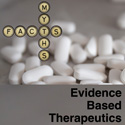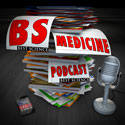Episode 105: A higher dose of chronic asthma therapeutics
In episode 105, James and Mike continue on with breathless abandon their discussion about the use of drugs in asthma. With chronic asthma the whole concept of low dose and shared-informed decision making comes right back into focus (thank goodness) and so both of us rest easy that the last 104 podcasts, at least from that perspective, have not been a waste of time.
Show notes
1) PRN versus chronic use of inhaled salbutamol
2) Inhaled corticosteroids in patients with new-onset asthma
“all patients with mild persistent asthma deserve the opportunity to decide whether the benefit from their use is worth the effort of taking a very safe medication, usually once daily”
Am J Res Crit Care Med 2005;172:410-2
3) Choice of inhaled corticosteroid – no difference
Ann Allergy Asthma Immunol 2003;91:326-34
4) Doses of inhaled corticosteroid – low doses
“published data provide little support for dose titration above 400 mcg/d in patients with mild to moderate asthma”
5) Equipotent daily doses of inhaled corticosteroids in adults – the doses listed below are considered ‘low” doses, “moderate doses = doubling these doses; “high” doses = quadrupling these doses. In children the corresponding doses are usually about 2/3 of the adult doses
Triamcinolone/Flunisolide 400/500-1000 mcg
Beclomethasone 200-500 mcg
Budesonide /Mometasone 200-400 mcg
Fluticasone 100-250 mcg
Ciclesonide 80-160 mcg
6) Doubling the dose of inhaled CS when symptoms get worse provides no benefit
7) Maybe quadrupling the dose will work????
Am J Respir Crit Care Med 2009;180:598–602
8) High dose inhaled corticosteroids can often be reduced without any change in symptom control
9) After inhaled steroids what’s next – tiotropium or salmeterol?
10) LABA vs LTRA
“In asthmatic adults inadequately controlled on low doses of inhaled steroids, the addition of LABA is superior to LTRA for preventing exacerbations requiring systemic steroids, and for improving lung function, symptoms, and use of rescue ß2-agonists”
11) Peak flow measurements


